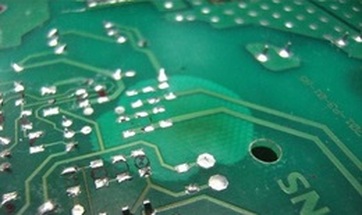The main reason why FR4 PCB's delaminate during the reflow soldering process is due to moisture being present within the FR4 material that has expanded causing internal layers to separate - see photo above.
It is important to be sure that the correct grade of material is being used with an appropriate specification for the intended assembly process. For example if the assembly is 'Lead-Free' then generally a higher reflow soldering temperature will be needed and therefore a material with a higher Tg (Glass Transition Temperature).
Although the presence of moisture can cause the FR4 layers to separate, quite often the root cause of the problem could be due to a defect during the PCB manufacturing process.
FR4 is a 'Hygroscopic' material and will absorb moisture from the atmosphere and so once the PCB's are fabricated they should be vacuum sealed. If there is concern over the way in which the PCB's have been sealed then the PCB's should be pre-baked prior to assembly to remove moisture following the guidelines detailed in IPC 1601.
It is important to be sure that the correct grade of material is being used with an appropriate specification for the intended assembly process. For example if the assembly is 'Lead-Free' then generally a higher reflow soldering temperature will be needed and therefore a material with a higher Tg (Glass Transition Temperature).
Although the presence of moisture can cause the FR4 layers to separate, quite often the root cause of the problem could be due to a defect during the PCB manufacturing process.
FR4 is a 'Hygroscopic' material and will absorb moisture from the atmosphere and so once the PCB's are fabricated they should be vacuum sealed. If there is concern over the way in which the PCB's have been sealed then the PCB's should be pre-baked prior to assembly to remove moisture following the guidelines detailed in IPC 1601.
|
Return to home page
|

